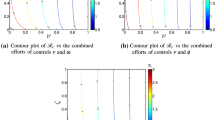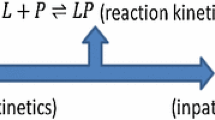Abstract
In this study, we examine the interaction between drug addiction and the contagion of HIV/AIDS in Iranian prisons. We provide a simple mathematical model for such an interaction. The stability of drug addiction and HIV/AIDS models are analyzed separately with no medical treatment. Then, we present an improved model describing the effect of treatment of drug users on the spread of HIV/AIDS. This fully extended model is obtained by adding some new parameters for the treatment of drug addiction. The impact of rehabilitating treatments on the control of HIV/AIDS spread in prisons is investigated, and finally, the reproduction numbers are compared in cases where there is no cure or some treatment methods are available.

Similar content being viewed by others
References
J.D. Murray, Mathematical Biology: I: An Introduction, 3rd edn. (Springer, New York, 2002)
J.C. Misra, Biomathematics: Modelling and Simulation (World Scientific, Singapore, 2006)
B.P. Ingalls, Mathematical Modeling in Systems Biology: An Introduction (MIT Press, London, 2013)
A. Babaei, S. Banihashemi, A stable numerical approach to solve a time-fractional inverse heat conduction problem. Iran J. Sci. Technol. Trans. A 42(4), 2225–2236 (2017)
P.T. Sowndarrajan, J. Manimaran, A. Debbouche, L. Shangerganesh, Distributed optimal control of a tumor growth treatment model with cross-diffusion effect. Eur. Phys. J. Plus 134, 463 (2019)
E.K. Akgül, Solutions of the linear and nonlinear differential equations within the generalized fractional derivatives. Chaos Interdiscip. J. Nonlinear Sci. 29(2), 023108 (2019)
H. Jafari, A. Babaei, S. Banihashemi, A novel approach for solving an inverse reaction-diffusion-convection problem. J. Optim. Theory Appl. 183, 688–704 (2019)
A. Atangana, A. Akgül, Can transfer function and Bode diagram be obtained from Sumudu transform. Alexandria Eng. J. (2020). https://doi.org/10.1016/j.aej.2019.12.028
R.M. Anderson, G.F. Medly, R.M. May, A.M. Johnson, A preliminary study of the transmission dynamics of the human immunodeficiency virus (HIV), the causative agent of aids. IMA J. Math. Appl. Med. Biol. 3(4), 229–263 (1986)
I.S. Nikolaos, K. Dietz, D. Schenzle, Analysis of a model for the pathogenesis of AIDS. Math. Biosci. 145(1), 27–46 (1997)
K.O. Okosun, M.A. Khan, E. Bonyah, S.T. Ogunlade, On the dynamics of HIV-AIDS and cryptosporidiosis. Eur. Phys. J. Plus 132, 363 (2017)
A.R. Carvalho, C.M. Pinto, D. Baleanu, HIV/HCV coinfection model: a fractional-order perspective for the effect of the HIV viral load. Adv. Differ. Equ. 2018(1), 1–22 (2018)
N. Bacaër, Ri, C. Pretorius, R. Wood, B. Williams, Modeling the joint epidemics of TB and HIV in a South African township. J. Math. Biol. 57(4), 557–593 (2008)
S. Arshad, D. Baleanu, W. Bu, Y. Tang, Effects of HIV infection on CD4+ T-cell population based on a fractional-order model. Adv. Differ. Equ. 2017(1), 92 (2017)
A. Babaei, H. Jafari, M. Ahmadi, A fractional order HIV/AIDS model based on the effect of screening of unaware infectives. Math. Methods Appl. Sci. 42(7), 2334–2343 (2019)
A.D. AlAgha, A.M. Elaiw, Stability of a general reaction-diffusion HIV-1 dynamics model with humoral immunity. Eur. Phys. J. Plus 134, 390 (2019)
C.P. Bhunu, W. Garira, Z. Mukandavire, Modeling HIV/AIDS and tuberculosis coinfection. Bull. Math. Biol. 71, 1745–1780 (2009)
Z. Mukandavire, A.B. Gumel, W. Garira, J.M. Tchuenche, Mathematical analysis of a model for HIV-MALARIA co-infection. Math. Biosci. Eng. 6(2), 333–362 (2009)
A. Babaei, H. Jafari, M. Ahmadi, Presenting a mathematical model and investigating effects of contaminated needle sharing on prevalence of HIV/AIDS disease. J. Adv. Math. Model 5(2), 91–108 (2016)
A. Jajarmi, D. Baleanu, A new fractional analysis on the interaction of HIV with CD\(4^{+}\) T-cells. Chaos Solitons Fractals 113, 221–229 (2018)
S. Kumar, S. Jain, Assessing the effects of treatment in HIV-TB co-infection model. Eur. Phys. J. Plus 133, 294 (2018)
A.I. Aliyu, A.S. Alshomrani, Y. Li, D. Baleanu, Existence theory and numerical simulation of HIV-I cure model with new fractional derivative possessing a non-singular kernel. Adv. Differ. Equ. 2019(1), 408 (2019)
P.K. Gupta, A. Dutta, A mathematical model on HIV/AIDS with fusion effect: Analysis and homotopy solution. Eur. Phys. J. Plus 134, 265 (2019)
C.M. Pinto, A.R. Carvalho, D. Baleanu, H.M. Srivastava, Efficacy of the post-exposure prophylaxis and of the HIV latent reservoir in HIV infection. Mathematics 7(6), 515 (2019)
A. Raza, M. Rafiq, D. Baleanu, M.S. Arif, M. Naveed, K. Ashraf, Competitive numerical analysis for stochastic HIV/AIDS epidemic model in a two-sex population. IET Syst. Biol. 13(6), 305–315 (2019)
M.F. Tabassu, M. Saeed, A. Akgül, M. Farman, N.A. Chaudhry, Treatment of HIV/AIDS epidemic model with vertical transmission by using evolutionary Padé-approximation. Chaos Solitons Fractals 134, 109686 (2020)
M. Beg, Update on HIV in prisons and other closed settings, Joint United Nations Programme on HIV/AIDS (UNAIDS). (2017) Retrieved from UNAIDS website: https://www.unaids.org/sites/default/files/media_asset/20171213_UNAIDS_PCB41_Update-HIV-Prisons-UNODC_PPT.pdf
J. Stone et al., Incarceration history and risk of HIV and hepatitis C virus acquisition among people who inject drugs: a systematic review and meta-analysis. Lancet Infect. Dis. 18(12), 1397–1409 (2018)
P. Driessche, J. Watmough, Reproduction numbers and sub-threshold endemic equilibria for compartmental models of disease transmission. Math. Biosci. 180(1), 29–48 (2002)
Author information
Authors and Affiliations
Corresponding author
Rights and permissions
About this article
Cite this article
Babaei, A., Jafari, H. & Liya, A. Mathematical models of HIV/AIDS and drug addiction in prisons. Eur. Phys. J. Plus 135, 395 (2020). https://doi.org/10.1140/epjp/s13360-020-00400-0
Received:
Accepted:
Published:
DOI: https://doi.org/10.1140/epjp/s13360-020-00400-0




